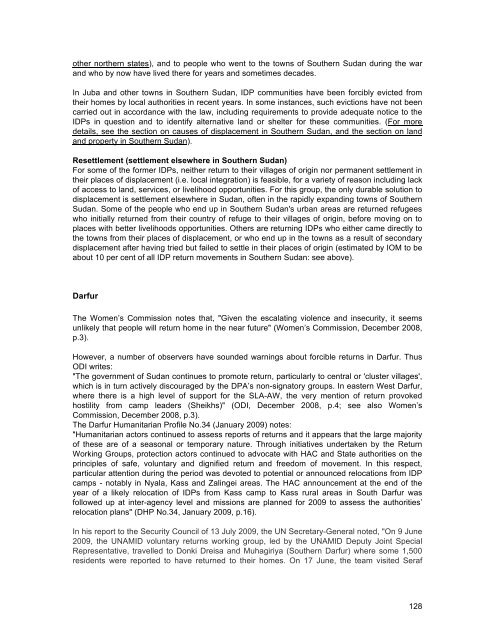SUDAN: Durable solutions elusive as southern IDPs return and ...
SUDAN: Durable solutions elusive as southern IDPs return and ...
SUDAN: Durable solutions elusive as southern IDPs return and ...
You also want an ePaper? Increase the reach of your titles
YUMPU automatically turns print PDFs into web optimized ePapers that Google loves.
other northern states), <strong>and</strong> to people who went to the towns of Southern Sudan during the war<br />
<strong>and</strong> who by now have lived there for years <strong>and</strong> sometimes decades.<br />
In Juba <strong>and</strong> other towns in Southern Sudan, IDP communities have been forcibly evicted from<br />
their homes by local authorities in recent years. In some instances, such evictions have not been<br />
carried out in accordance with the law, including requirements to provide adequate notice to the<br />
<strong>IDPs</strong> in question <strong>and</strong> to identify alternative l<strong>and</strong> or shelter for these communities. (For more<br />
details, see the section on causes of displacement in Southern Sudan, <strong>and</strong> the section on l<strong>and</strong><br />
<strong>and</strong> property in Southern Sudan).<br />
Resettlement (settlement elsewhere in Southern Sudan)<br />
For some of the former <strong>IDPs</strong>, neither <strong>return</strong> to their villages of origin nor permanent settlement in<br />
their places of displacement (i.e. local integration) is fe<strong>as</strong>ible, for a variety of re<strong>as</strong>on including lack<br />
of access to l<strong>and</strong>, services, or livelihood opportunities. For this group, the only durable solution to<br />
displacement is settlement elsewhere in Sudan, often in the rapidly exp<strong>and</strong>ing towns of Southern<br />
Sudan. Some of the people who end up in Southern Sudan's urban are<strong>as</strong> are <strong>return</strong>ed refugees<br />
who initially <strong>return</strong>ed from their country of refuge to their villages of origin, before moving on to<br />
places with better livelihoods opportunities. Others are <strong>return</strong>ing <strong>IDPs</strong> who either came directly to<br />
the towns from their places of displacement, or who end up in the towns <strong>as</strong> a result of secondary<br />
displacement after having tried but failed to settle in their places of origin (estimated by IOM to be<br />
about 10 per cent of all IDP <strong>return</strong> movements in Southern Sudan: see above).<br />
Darfur<br />
The Women’s Commission notes that, "Given the escalating violence <strong>and</strong> insecurity, it seems<br />
unlikely that people will <strong>return</strong> home in the near future" (Women’s Commission, December 2008,<br />
p.3).<br />
However, a number of observers have sounded warnings about forcible <strong>return</strong>s in Darfur. Thus<br />
ODI writes:<br />
"The government of Sudan continues to promote <strong>return</strong>, particularly to central or 'cluster villages',<br />
which is in turn actively discouraged by the DPA’s non-signatory groups. In e<strong>as</strong>tern West Darfur,<br />
where there is a high level of support for the SLA-AW, the very mention of <strong>return</strong> provoked<br />
hostility from camp leaders (Sheikhs)" (ODI, December 2008, p.4; see also Women’s<br />
Commission, December 2008, p.3).<br />
The Darfur Humanitarian Profile No.34 (January 2009) notes:<br />
"Humanitarian actors continued to <strong>as</strong>sess reports of <strong>return</strong>s <strong>and</strong> it appears that the large majority<br />
of these are of a se<strong>as</strong>onal or temporary nature. Through initiatives undertaken by the Return<br />
Working Groups, protection actors continued to advocate with HAC <strong>and</strong> State authorities on the<br />
principles of safe, voluntary <strong>and</strong> dignified <strong>return</strong> <strong>and</strong> freedom of movement. In this respect,<br />
particular attention during the period w<strong>as</strong> devoted to potential or announced relocations from IDP<br />
camps - notably in Nyala, K<strong>as</strong>s <strong>and</strong> Zalingei are<strong>as</strong>. The HAC announcement at the end of the<br />
year of a likely relocation of <strong>IDPs</strong> from K<strong>as</strong>s camp to K<strong>as</strong>s rural are<strong>as</strong> in South Darfur w<strong>as</strong><br />
followed up at inter-agency level <strong>and</strong> missions are planned for 2009 to <strong>as</strong>sess the authorities’<br />
relocation plans" (DHP No.34, January 2009, p.16).<br />
In his report to the Security Council of 13 July 2009, the UN Secretary-General noted, "On 9 June<br />
2009, the UNAMID voluntary <strong>return</strong>s working group, led by the UNAMID Deputy Joint Special<br />
Representative, travelled to Donki Dreisa <strong>and</strong> Muhagiriya (Southern Darfur) where some 1,500<br />
residents were reported to have <strong>return</strong>ed to their homes. On 17 June, the team visited Seraf<br />
128
















